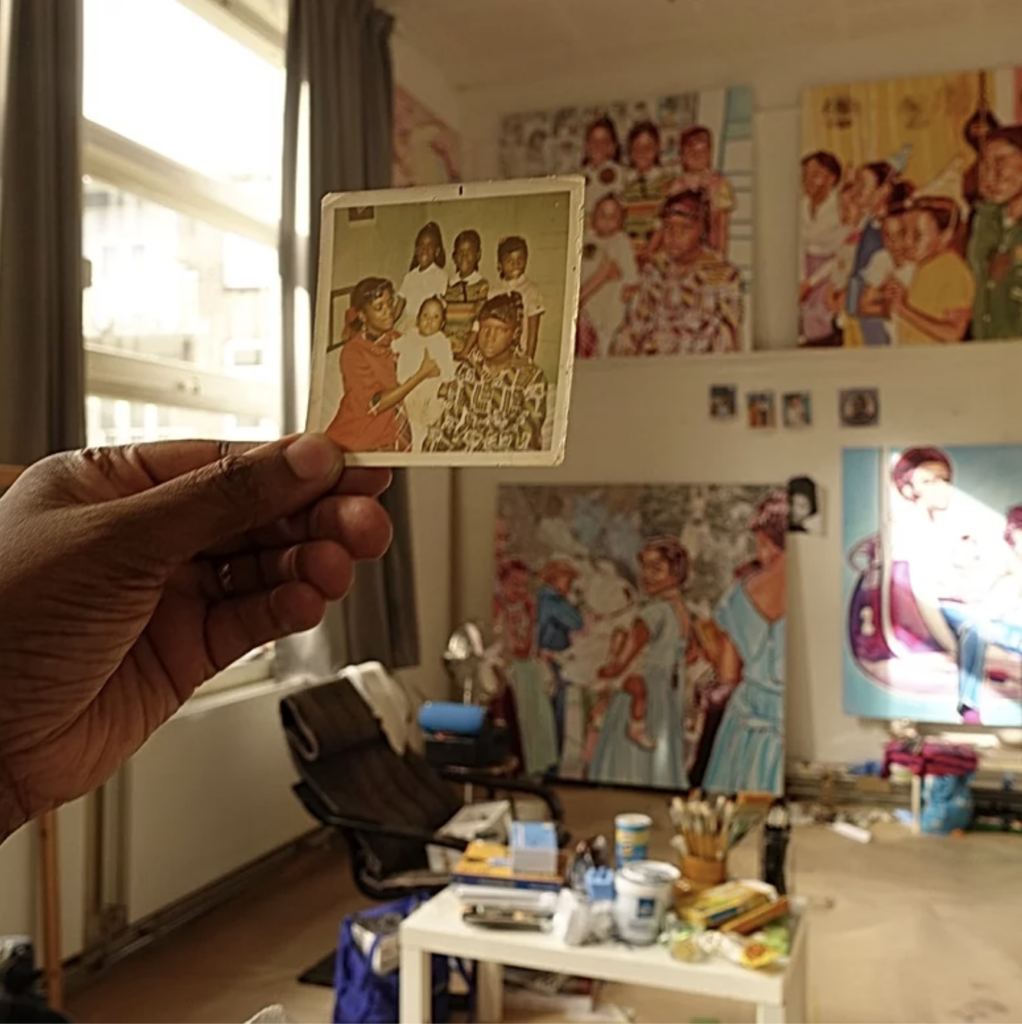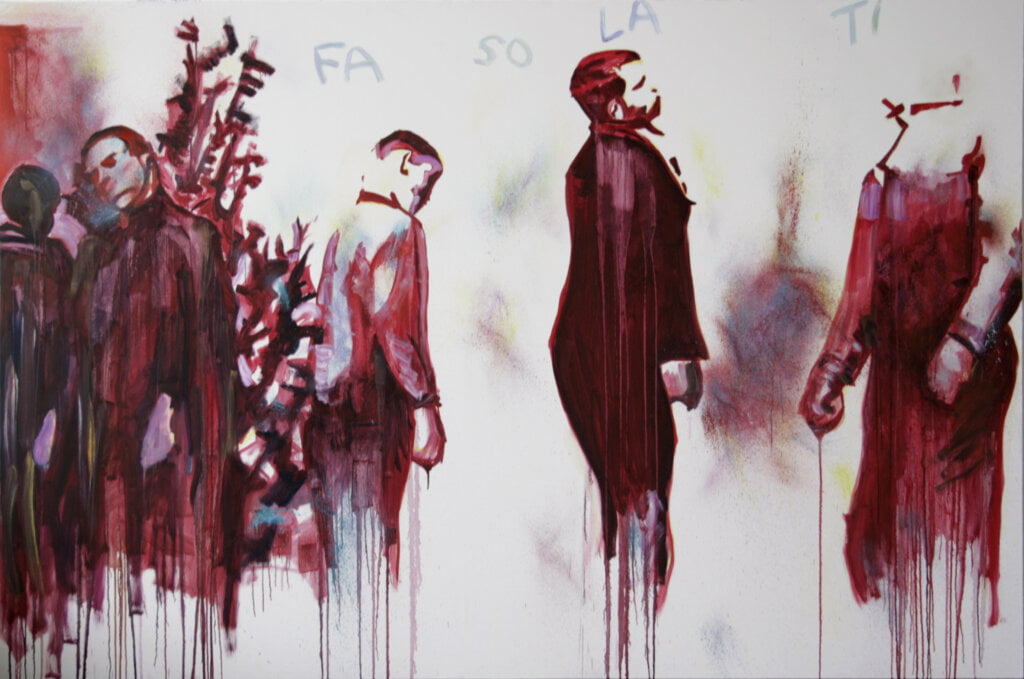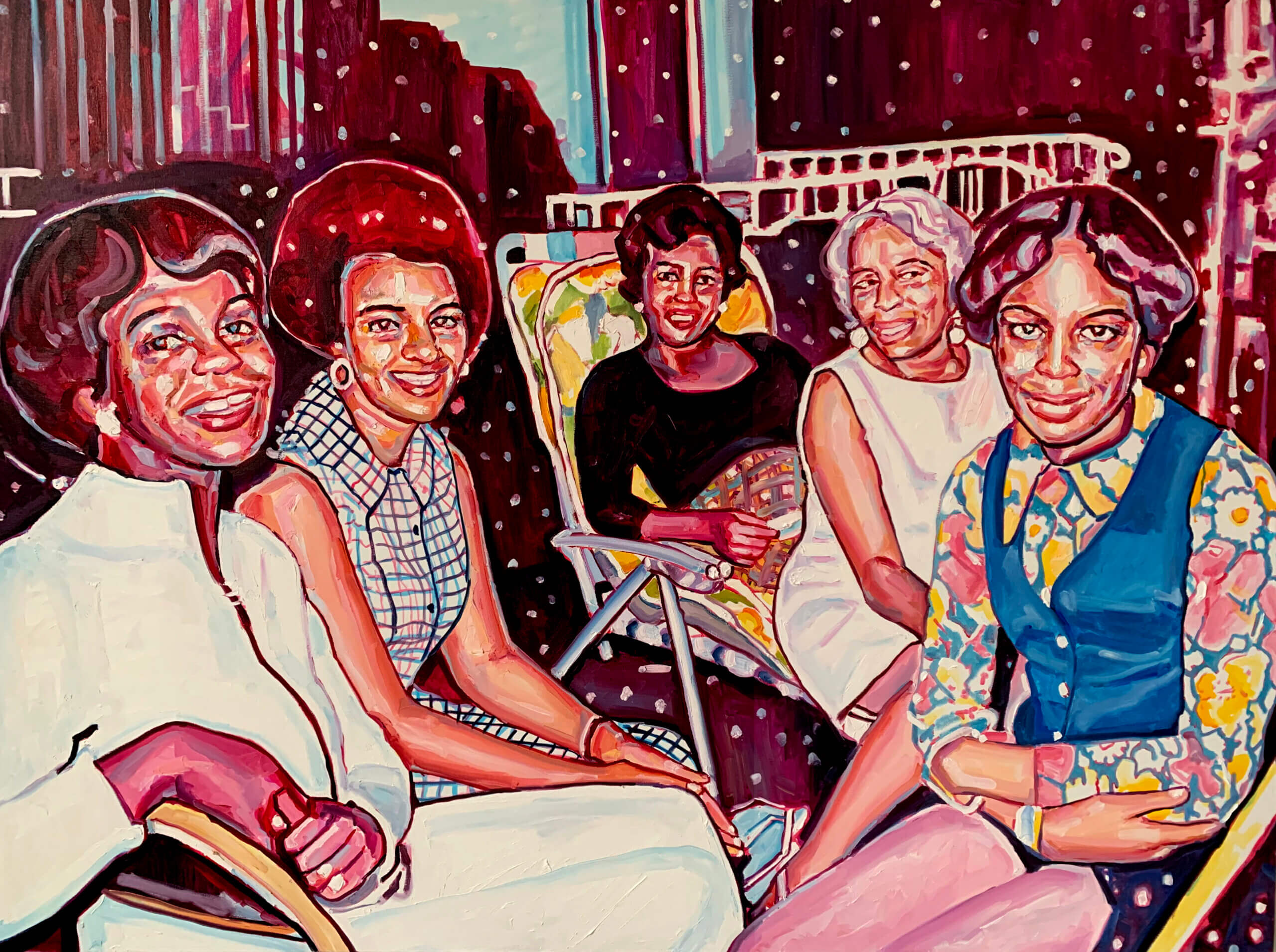Portrait artist Esiri Erheriene-Essi’s depiction of skin is masterful: her figures glow as if in the dappled light of the Impressionists. The artist translates found vintage photographs into glorious technicolour, reminding us that the people of the past didn’t exist in a distant monochrome reality, but lived, breathed, and existed fully. The “magic” of painting, as Erheriene-Essie calls it, brings her characters to life.

I grew up not seeing myself or people like me on the white walls of museums and galleries and now I get to fill those same spaces with paintings of black people.
Esiri Erheriene-Essi
In an exclusive interview with Art Plugged, Esiri discusses the influence of the African Diaspora, “passion and delusion”, and never finishing a painting.
Q: First things first, why do you do what you do?
Esiri Erheriene-Essi: Because Lucian Freud’s brushstrokes bewitched me at an impressionable age and I think painting is the most magical thing. So I spend my days moving squishy pigment around on canvas and I love it.
Q: What is your inspiration?
Esiri Erheriene-Essi: The black African diaspora, vintage photographs and German expressionistic painting.
Q: What is your creative process when you’re creating?
Esiri Erheriene-Essi: My creative process always begins with a photo I’ve seen that I can’t get out of my head. In his book Camera Lucida, Roland Barthes tells this anecdote of seeing a photo of Napoleon’s brother Jerome and he went into a trance over it and couldn’t get over how he was looking into eyes that had looked at Napoleon.
The people that capture my attention aren’t as famous as Napoleon’s brother but they unleash that same feeling of amazement within me and this propels me into the studio to paint them. So, I start with a photo that I edit in photoshop. Then in the studio I make a sketch with acrylic ink which allows me to block in the colours in one sitting and the underpainting is dry within an hour which is faster than thin washes of oil.

I then decide whether or not to add xerox transfers which can take anywhere between a day or a week to add on, and then I start painting with oil paint. I work in layers and intuitively collaborate with the source image in bringing out the painting. I can do this since I spend so much time, both working with and thinking about the image before I get to this moment – intuition is fundamentally rooted in the prep work.
Q: Which is your preferred surface for working on?
Esiri Erheriene-Essi: I love working on canvas. For the last year I’ve been working on pre stretched linen on aluminium frames and they are perfect.
Q: What would you say is an integral part to the work of an Artist?
Esiri Erheriene-Essi: Questioning and probing the world that we live in. Using imagination to not show how the world is, but rather showing alternate realities of how the world could and, maybe even, should be.
Q: What is the reason behind your use of history, memories and old imagery in your work?
Esiri Erheriene-Essi: That comes from the fact that I’m a British born Nigerian and the lack of proper history education at secondary school. For Black History Month every year my class learned of American Slavery, African American Civil Rights history and that black people turned up out of the blue to Britain in the 1950s after World War II.

And at home I’d learn of a different history of the Urhobo people, ancient Nigerian mythology and the history of my family – many whom I’d never met but my parents would show me photographs of my grandparents and great-grandparents and I found it fascinating. The older I got the more I started searching beyond the sanitised white canonical narratives within history and started incorporating the often overlooked, and ignored histories of black people from the African diaspora.

(2019), 135 x 135 cm, oil, ink and xerox transfer on linen
Because I wanted to explore the quiet richness and experiences within our stories. I use old colour photographs as they show various histories through diverse personal lenses and because of the racial bias that is inherent to the technology of colour photography which was engineered for white skin.
Q: How do you know when a piece is finished?
Esiri Erheriene-Essi: I’ve never finished a painting in my life, I just stop before I ruin it.
Q: What is your favourite piece from your collection?
Esiri Erheriene-Essi: I don’t have one I have a few. A painting called ‘Riders on the Storm’ from 2008 that I made when I was at art school, it was supposed to be an underpainting but I guess I only could have ruined it if I had continued to work on it. Another one is a painting called ‘The Usual Suspects’ from 2014 that is based on an image from my favourite photograph by Gordon Parks.

I painted it right after seeing a retrospective of Kerry James Marshall in Antwerp and it is one of my most favourite things I’ve ever painted. Another favourite is a painting from last year called ‘Luster’s Pink Original’ of a dinner party. I love the way the figures look and how the xerox transfers works in relation to the painted surfaces. Everyone glows.

Q: How did you feel when you did your first solo exhibition?
Esiri Erheriene-Essi: I was so nervous that I threw up. It was in a small space in Rotterdam and I took over 2 floors with work made over a two-year period. I’d only ever been in group exhibitions at that point and I was nervous that I had to carry the whole thing. Ideas I found funny in the privacy of my studio were up on the walls ready to be seen and I was afraid it wouldn’t translate well and I’d be ridiculed.

oil, ink and xerox transfer on linen
The exhibition was called ‘I don’t like Nostalgia, unless it’s mine’ and when it opened and I got a beer in me I was super proud and felt extremely lucky to have been given an opportunity to show my work. And when people and a museum bought work from the show I felt that I was no longer an interloper but a proper artist with something to say.
Q: What is the most rewarding thing for you about being a part of the Art Industry?
Esiri Erheriene-Essi: That I get to rebalance the lack of proper representation in the art world. I grew up not seeing myself or people like me on the white walls of museums and galleries and now I get to fill those same spaces with paintings of black people.
I get really touched when people take the time to get in contact with me to tell me they’ve enjoyed my paintings in an exhibition and have gone back several times and brought friends and family just because they could see paintings that they could relate to and see themselves in.
I never had that experience growing up and that is a big reason why I started making art – to make what I couldn’t see – and to read these messages from strangers just fills me with so much love. Once I had the privilege of meeting a group of young kids at an exhibition of mine, they were blown away by the fact that for the first time they saw images that could have been a part of their lives in a museum and I could not help myself but to cry when I heard this. I’m not sure if this really has anything to do with that which makes art an industry but it’s the most rewarding aspect of being an artist for me.

Q: Is there anything that worries you about how social media is affecting the promotion of artists?
Esiri Erheriene-Essi: Not really. If anything social media has opened up the playing field and brought much needed diversity to the art world.
There are of course people that are more into the aesthetics of being an artist and the superficial side of getting likes and followers, but I’ve discovered so many artists via Instagram that are all over the world and I love that I get to see shows in NYC or Johannesburg or Lagos or Accra from the click of a finger.

153 x 153 cm, oil, ink and xerox transfer on linen
Q: In your opinion, do you have any advice for artists on how to manage their social media image? Or does it even need managing?
Esiri Erheriene-Essi: I wouldn’t know. I just post images of my work either finished or work in progress or my kid sleeping through a trip to my exhibition just because I like sharing my process. I don’t know how to manage personas.
Q: Do you have any advice for artists starting and don’t know where to begin?
Esiri Erheriene-Essi: Passion and delusion are half of it. I never knew how to become an artist I just wanted to paint and I just applied for anything that would mean I get to paint for a bit – such as art school, funded artist residencies etc and 12 years later I’m still plugging away. So maybe the advice is to not give up, take risks and trust yourself. And to not think that you have to be too selective, sure be critical when you think about what you show where or who is paying for what but I have seen people turn down perfectly good opportunities, thinking that it is beneath them and now they don’t get any offers at all.
I once said yes to make a few paintings for a themed exhibition because I trusted the sincerity of the curator in relation to the framework of the exhibition. It was in a library and my works were hanging on butt ugly partition walls but you know what, the exhibition was great and on another one of these walls, that were pathetic excuses compared to museum walls, there was some paintings of Marlene Dumas.

135 x 135 cm, oil, ink and xerox transfer on linen
Q: What would you say is the best way of getting your art noticed in the age of the internet?
Esiri Erheriene-Essi: Instagram is pretty good if you’re savvy with the tags. I’ve found a lot of artists I’d never heard of by accident just by using certain tags that I was interested in such as ‘vernacular photography’ or ‘Kerry James Marshall’ and artwork stumbled onto my feed which I then went and followed. There is so much stuff out in the world so it’s luck that makes us stop for a moment to take notice of something.

210 x 150 cm, oil, ink and xerox transfer on linen
Q: Are there any places where you feel Art and Technology really shouldn’t overlap?
Esiri Erheriene-Essi: The two are constantly overlapping and I think that at times it’s a good thing, it means institutions are not the only gatekeepers of art and there are more diverse representations available on various platforms
Although at the same time, problems can arise when technology is used as a substitute for things such as community. We can use our current situation with the corona lockdown as an example – I am teaching at an art academy and we are using technology to keep up with the teaching online.
Sure, it is great that we can stay in contact with the students and support them as good as possible, but on the other hand it is not a full worthy replacement. The job gets done but nothing can replace face to face contact and the experiencing of art in person.
https://www.instagram.com/esiri.essi/
©2020 Esiri Erheriene-Essi



